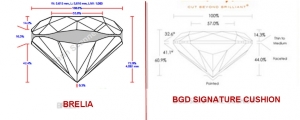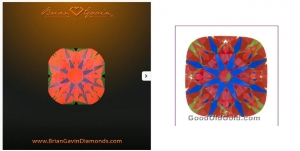My g/f really likes sqaure H&As, especially cushions. I've noticed that the Brellias are almost uniformly square (maybe off by a few hundredths of a millimeter) but all of Gavin's H&A cushions are more rectangular, off by more than a millimeter on the bigger stones. I'm guessing this is by design, but I'd be interested to hear people's opinions on the two.
You are using an out of date browser. It may not display this or other websites correctly.
You should upgrade or use an alternative browser.
You should upgrade or use an alternative browser.
Brellia vs. Gavin H&A Cushion
- Thread starter CJG
- Start date
- Joined
- Feb 14, 2005
- Messages
- 4,156
There was a very detailed thread about this very issue recently
https://www.pricescope.com/community/threads/new-line-of-brian-gavin-signature-cushion-cuts.191403/
The BG stone appears to be measured across the diagonal, but I'm not sure about the GOG.
Are you in the trade? (If not, contact admin to have your status changed)
https://www.pricescope.com/community/threads/new-line-of-brian-gavin-signature-cushion-cuts.191403/
The BG stone appears to be measured across the diagonal, but I'm not sure about the GOG.
Are you in the trade? (If not, contact admin to have your status changed)
- Joined
- Jan 20, 2009
- Messages
- 1,299
ecf8503|1378486679|3515721 said:There was a very detailed thread about this very issue recently
https://www.pricescope.com/community/threads/new-line-of-brian-gavin-signature-cushion-cuts.191403/
The BG stone appears to be measured across the diagonal, but I'm not sure about the GOG.
Are you in the trade? (If not, contact admin to have your status changed)
There was some confusion on my part about how the Brian Gavin Signature Cushion is measured, which is reflected within that thread, so for the point of clarification, the measurements for the diamond are as follows:
The first measurement represents the longest corner-to-corner measurement, diagonally across the diamond.
The second measurement is the shortest distance across the diamond, like from East to West, or North to South.
The third measurement is the depth of the diamond from the top of the table facet, through the body of the diamond, down to the point of the culet.
Obviously the facet design of the Brellia and Brian Gavin Signature Cushion are different, this will result in each diamond displaying a different degree of sparkle, since the facet structure will have a direct effect upon the size, number, and shape of the virtual facets, and the sparkle which is produced as a result... larger flashes of light are easier for our eyes to interpret as colored light, and smaller flashes of light will be seen as white light (I'm over simplifying this, but there are other threads to be found on this subject).
Another difference is the girdle thickness of the two diamonds, take a look at the side profiles of the diamond, as well as the photographs that each manufacturer provides, and the differences in girdle thickness as indicated on the diamond grading reports, for more insight into this difference.
I want to be extremely clear that my comments above should not be interpreted as a preference for either the Brellia, or the Brian Gavin Cushion Cut Diamond. I have had the opportunity to play with the Brian Gavin Cushion on several occasions over the past few months, but have not seen the Brellia in-person, thus I have no idea how it looks in terms of brilliance, dispersion, and scintillation... nor could I provide any indication of such, since I am a trade member.
I'm relatively certain that both diamonds are beautiful in their own right, the decision to purchase one over the other, will most likely come down to whether each vendor happens to have a diamond with the characteristics that the customer is looking for at that particular time, e.g. carat weight, color, clarity, etc., it's no small feat to hit the mark for AGS Ideal-0 Light Performance for these puppies, so they should be outstanding looking stones, regardless of which one you choose.
- Joined
- Sep 6, 2013
- Messages
- 1
Todd Gray said:Another difference is the girdle thickness of the two diamonds, take a look at the side profiles of the diamond, as well as the photographs that each manufacturer provides, and the differences in girdle thickness as indicated on the diamond grading reports, for more insight into this difference.
I want to be extremely clear that my comments above should not be interpreted as a preference for either the Brellia, or the Brian Gavin Cushion Cut Diamond.
I have had the opportunity to play with the Brian Gavin Cushion on several occasions over the past few months, but have not seen the Brellia in-person, thus I have no idea how it looks in terms of brilliance, dispersion, and scintillation... nor could I provide any indication of such, since I am a trade member.
Todd I find your posts in this thread and the other one to be unbalanced and it is unclear whether you are trade (you have no badge) and/or whether you sell the BGD signature. For this reason I have been compelled to provide a more comprehensive comparison of the two diamonds.
1. AGSL has three measurements on the grading report for a BGD signature cushion:
1) the first one is the average of the two flat to flat measurements (average of shortest distances length and width flat edges).
2) The second one is the the average of the longest distances from corner to corner.
3) The third one is the height of the diamond from culet to the table.
The depth percentage is calculated using the height divided by the average of the longest corner to corner distances.
This type of measurement and difference from all other cushions AGSL grades is the direct result of the request by Brian himself to have them use this method so depth % can be compared to those of rounds as a marketing tool.
One example:
BGD Signature
AGS Report 104065051007
Dimensions 5.04 X 5.95 X 3.67
Depth 61.7%
Similar Weight Brellia
AGS Report 104065077012
Dimensions 5.08 X 5.07 X 3.60
Depth 71.1%
I will allow the readers themselves to draw their own conclusions, but there should be no doubt these diamonds in actual fact have almost identical proportions. The depths are not ~10% different at all.
2. In terms of physical facet structure the Brelia and BGD signature are a lot closer than one might realize. The Brelia has a thick 'filed off' girdle creating flat edges. The BGD signature has steep lower girdle facets and an extra row of pavilion facets that provide intermediate angles between the steep LGFs and the pavilion mains. The Brellia also has split UGFs whereas the BGD signature does not.

3. In terms of light performance:
Brightness:
In terms of brightness (From ASET) - The BGD has questionable edge to edge brilliance and reduced performance along the flat edges in the region of those steep LGFs. This can be observed by ASET green regions along the edges.
The Brellia shows little if any negative brightness as a result of the thick girdle in the ASET 30 or plain photographs.

Fire Potential
I don't think anyone could properly compare the two without seeing them side by side considering Fire Potential and Scintillation.
Theoretically the two should be quite similar in Fire Potential (almost identical CA/PA and Crown Height) but if anything a slight edge to the Brellia due to its larger VFs(flashes) and the greater potential for facet clipping.
Scintillation
Theoretically in terms of scintillation the two should also be quite similar. Although the Brellia should have slightly larger VFs(flashes) due to larger pavilion facet size. It is possible the BGD signature could have faster on/off scintillation due to an overall smaller average VF size . Whether these differences would be noticeable to the unaided eye could only be determined accurately by direct comparison in same lighting.
- Joined
- Sep 3, 2000
- Messages
- 6,742
I recently had the opportunity to put two BGD Signature H&A cushion cuts on my Imagem Verigem device and they both earned very high marks for light return. I have not ever had the opportunity to do the same with Brellia. The result of such a test might be considered an "objective" comparison. I would welcome an opportunity to provide such information to everyone on the forum. I will be writing up the results in a future article for Pricescope once I have a complete way of expressing the results and making comparison to those many high performance round diamonds that have already been tested with this equipment.
Admittedly, there is not yet one recognized standard for such light return grading, but AGSL has been a leader in this in terms of public and trade awareness. However, in the background, there are others who are going down slightly different technological pathways to bring resolution to this issue of comparing light performance in diamonds. We all would like to see objectivity, fairness and correctness brought to this part of diamond description.
Admittedly, there is not yet one recognized standard for such light return grading, but AGSL has been a leader in this in terms of public and trade awareness. However, in the background, there are others who are going down slightly different technological pathways to bring resolution to this issue of comparing light performance in diamonds. We all would like to see objectivity, fairness and correctness brought to this part of diamond description.
- Joined
- Sep 3, 2000
- Messages
- 6,742
I wanted to add that I do not like the idea of using diagonal measurements on cushion cut diamonds. BDG is not the first one to have it this way, but really, it is not gemologically useful. By GIA education and standards, all fancy shaped diamonds are measured for length, their longest measurement, then measured for width, their shortest measurement. The depth percentage is then the short measurement divided by the long measurement. This has significance. By such measures, on can describe a long, slender shape versus a middle of the road shape, or a near square shaped diamond. Measuring across the diagonals says nothing descriptive about the square nature or rectangular nature of a cushion cut diamond. If this was done on princess cuts, radiant or emerald cuts, we would have no idea of the relation of length to width. It is a poor way to measure a diamond in order to describe how it looks. Of course, we understand why a seller would want the measurements to be on the diagonal, as it masks the outline description from everyone. It is nice the know the diagonal lengths, but the total depth ought to be based on the width of such a diamond divided by the length from the opposite, longer ends, never using any average of the diagonals. Whenever a diamond lab provides diagonal measures, they surely ought to provide the more useful traditional measurements, too.
The prime exception is a heart shape where the distance from the top of the heart lobes to the point is one measure and the distance across the lobes is the other measure. Heart shapes are not high performance stones, but we still want that kind of useful measurement.
The prime exception is a heart shape where the distance from the top of the heart lobes to the point is one measure and the distance across the lobes is the other measure. Heart shapes are not high performance stones, but we still want that kind of useful measurement.
Share:
Past, Present, Future: The Meaning of Three-Stone Engagement Rings Past, Present, Future: The Meaning of Three-Stone Engagement Rings - 04/14
Past, Present, Future: The Meaning of Three-Stone Engagement Rings - 04/14



300x240.png)